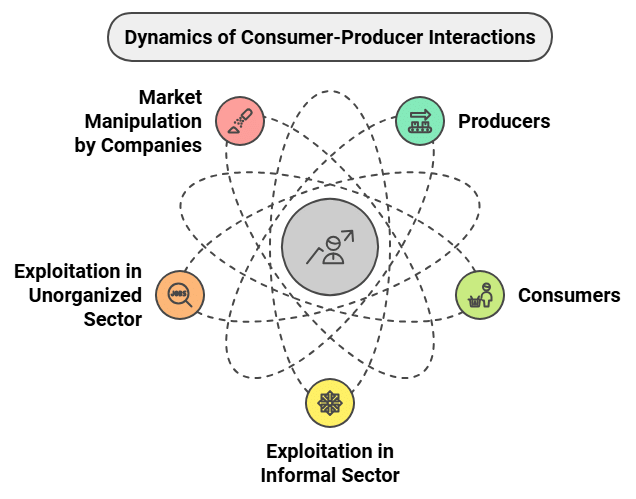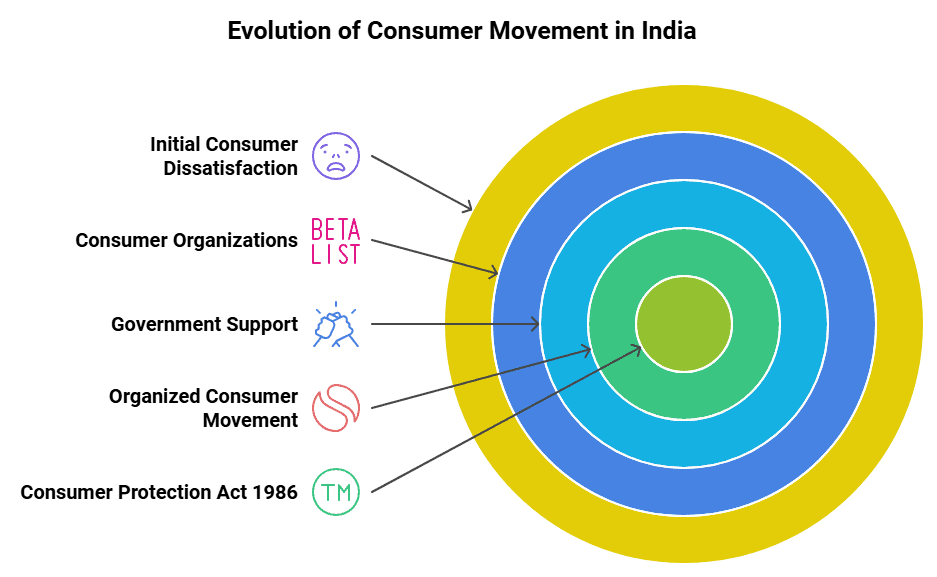Consumer Rights Summary Class 10 Social Science Chapter 5
| Table of contents |

|
| The Consumer in the Market Place |

|
| Consumer Movement |

|
| Consumer Rights |

|
| Taking the consumer movement forward |

|
The Consumer in the Market Place
- People participate in the market both as producers and consumers. As a producer they sell their goods and provide services to the needy people.
- Producers provide service in the sector like, agriculture sector or primary sector, secondary sector or manufacturing sector and service sector or tertiary sector.
- As a consumer, a person purchase goods and services that he/she need.
- Consumers exploited in the marketplace by the producers in various ways. In informal sector, borrowers are exploited by the moneylenders.
- People borrow money from moneylenders at high rate of interest and also forced by the moneylenders to pay the loan timely.
- In unorganized sector, people have to work at a low wage which is not fair.
- Sometimes, consumers get less weigh than what they should get and the producer also charged the price which is not maintained.
- Some big companies are manipulated the market in various ways like, by passing false information about the product through media and other sources to attract consumers. So, there is a need for rules and regulations to ensure protection for consumers.

Consumer Movement
- There are no for rules and regulations to ensure protection for consumers. The consumers are exploited by the producers.
- For example, if a consumer is not satisfied with the product of any brand or shop. Then he/she avoid and stop to purchase from that particular brand or shop.
- In this case, all the responsibilities are shifted to the consumer for purchasing of the products.
- When the consumers are dissatisfied with unfair rule and regulation for purchasing of goods and services, then the consumer movement is arisen.
- Here, unfair rule and regulation is indulged by the sellers. It is a type of social force.
- During 1960, Rampant food shortages, hoarding, black marketing, adulteration of food and edible oil gave birth to the consumer movement in an organized form in India.
- This organization receives financial support from the government for creating awareness among the people.
- Till the 1970s, consumer organizations formed consumer groups with increasing number of consumer organization.
- This group found to look into the malpractices in ration shops and overcrowding in the road passenger transport.
- In 1986, a major step was taken by the government of India in the form of the Consumer Protection Act 1986.

Consumer Rights
(i) Safety is everyone right
There are many goods and services which are hazardous for the health and property. So, that goods and services require special attention to safety. Consumers have the right to be protected against the marketing of goods and delivery of services which are hazardous for the health and services. Producers also need to follow the required rules and regulations for safety of consumers.
(ii) Information about goods and services
Manufacturer of goods and services should have maintained information about the ingredients used, price, batch number, date of manufacture, expiry date, the address of the manufacturer, directions for proper use’ and information relating to side effects and risks associated with usage of that particular goods and services. Consumers have right to know about the details of that particular goods and services that they purchased.
Right to Information Act
“Right to Information Act”, was enacted by the government of India in October 2005. The objective of this act is to ensure its citizens all the information about the functions of government departments. There are three reasons for formation of “Right to information”.
(i) When choice is denied
When a consumer is not satisfied with Purchasing of a particular goods and services then he/she have right to deny the choice.
(ii) Where should consumers go to get justice?
- When a consumer deny the choice. Then he/she has the right to seek redressal against unfair trade practices and exploitation. She/he has the right to get compensation depending on the degree of damage. For compensation she/he has to go consumer forums or consumer protection councils. This organization guide consumers on how to file cases in the consumer court.
- A three-tier quasi-judicial machinery at the district, state and national levels was set up for redressal of consumer disputes, under Consumer Protection Act.

- The district level court deals with the cases involving claims upto Rs 20 lakhs, the state level courts deal with cases between Rs 20 lakhs and Rs 1 crore and the national level court deals with cases involving claims exceeding Rs 1 crore.
- When a case is dismissed in district level court, then consumer can appeal in state and then in National level courts. This act provides “Right to Represent” to the consumer.
(iii) Learning earning to become well-informed consumer
For well-informed the consumer about their rights, Consumer Protection Act has led to the setting up of separate departments of Consumer Affairs in central and state governments.
Taking the consumer movement forward
- Indian Parliament enacted the Consumer Protection Act on 24 December 1986. After that every year 24 December is celebrated as the National Consumers’ Day.
- There are 20-25 are well organized and recognized consumer groups in India out of 200 consumer groups. After the enactment of “Consumer Protection Act” in India consumer awareness is spreading but slowly.
- The consumer redressal process is becoming cumbersome, expensive and time consuming.
(i) Consumers are required to engage lawyers.
(ii) In most purchases cash memos are not issued hence evidence is not easy to gather.
- ISI and Agmark: ISI and Agmark is quality certification for many products like, LPG cylinders, food colours and additives, cement or packed drinking water. It is compulsory for the producers to get certified by these organizations.
- Hallmark: Hallmark is quality certification for jewelry. This mark is issued by Indian Standard Organization which is located in New Delhi.
- ISO certification: International organization for standardization is quality certification which indicates companies, goods or, institutions having this certification meet the specific level of standard. The headquarter of ISO is situated in Geneva, which was established in 1947.
|
94 videos|630 docs|79 tests
|
FAQs on Consumer Rights Summary Class 10 Social Science Chapter 5
| 1. What are the basic consumer rights recognized in India? |  |
| 2. How did the consumer movement start in India? |  |
| 3. What role does the Consumer Protection Act play in safeguarding consumer rights? |  |
| 4. How can consumers take action if their rights are violated? |  |
| 5. What steps can be taken to further the consumer movement in India? |  |





















